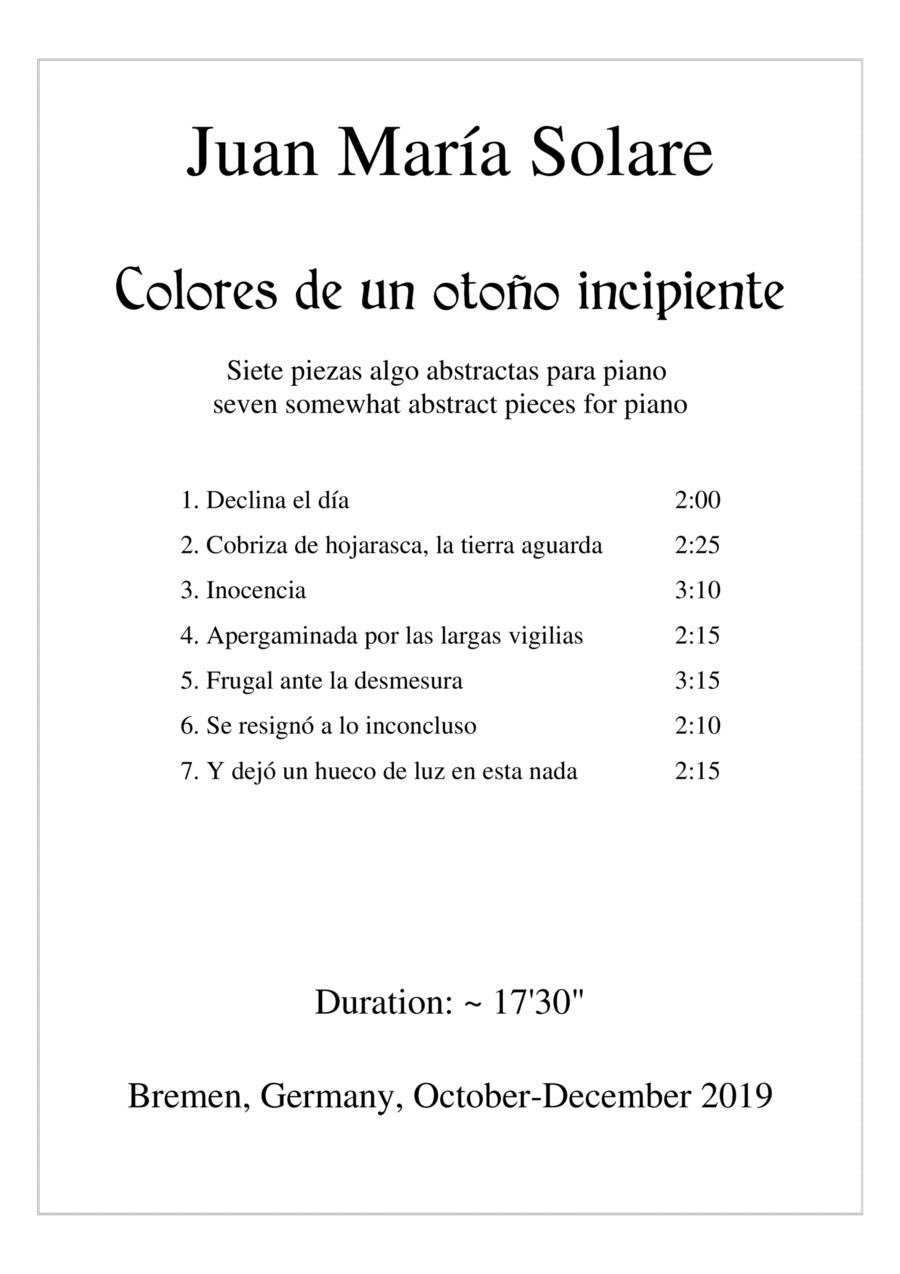Piano Solo - Level 3 - Digital Download SKU: A0.742752 By Juan MarÃa Solare. By Juan MarÃa Solare. 20th Century,Classical,Contemporary,Instructional. Score. 15 pages. Juan Maria Solare #350886. Published by Juan Maria Solare (A0.742752). Colores de un otoño incipiente -- Colors of an incipient autumn seven somewhat abstract pieces for piano Recording of Colores de un otoño incipiente - piano in several platforms Colores de un otoño incipiente -- on Spotify In this work, an idea that has haunted me for a long time crystallizes: that the titles of the individual pieces are read like lines of a poem. Colores de un otoño incipiente Declina el dÃa. Cobriza de hojarasca, la tierra aguarda. Inocencia Apergaminada por las largas vigilias. Frugal ante la desmesura, Se resignó a lo inconcluso Y dejó un hueco de luz en esta nada. Colors of an incipient autumn The day declines. Coppery with old leaves, the earth awaits. Innocence Parched by the long vigils. Frugal in the face of excess, He resigned himself to the unfinished And he left a hole of light in this nothingness. Such a poem alludes without great subtlety to decadence and aging. The title Apergaminada por las largas vigilias is taken from a poem by Pedro Lastra. Y dejó un hueco de luz en esta nada comes from a micropoem attributed to Alejandro Güerri, written in memory of Javier Adúriz. This seventh piece, transparent and delicate, pictures a being definitively transformed into light. The idea of desmesura (excess) arises from the prologue by Javier Adúriz to his book Solos de conciencia (1985): Faced with the excess of death, consciousness perceives the weakness of its willful affirmation, the one for which it feels itself unique and safe from all decrepitude. Adúriz was one of the fundamental figures in my artistic training. And apparently he still is. Musically, this cycle of works abounds in harmony of chords by fourths in a minimalist neoclassical aesthetic. The way of working texturally with the piano as an instrument - my instrument - highlights the pedal, the resonances, the third dimension of sound. These seven somewhat abstract pieces were composed at the end of 2019 in and around Bremen, in several cases with my new-born daughter Laura in my arms, trying to put her at to sleep and staying asleep. This explains the cautious nature of the music and its prudent dynamics that never reach a mezzoforte. There were several unsuccessful attempts to release this recording (initially planned for September 2020, at the beginning of autumn in the northern hemisphere). Finally, the album will be released (on Spotify and other streaming platforms) on 22 April 2022, coinciding with what would be my father's 103rd birthday. It is also autumn but in the southern hemisphere. Recorded on a Steinway B grand piano (serial number: 568208) at the Musikschule Bremen (Germany) with two Neumann KM-184 microphones. Recording and mastering technician: Alexander Derben. For the artwork, the impressive photographer and visual storyteller Leon Drago, from London, has kindly authorised the use of his photograph Pathway, The Garden House and Pergola, Hampstead Heath extension, London. The recording of Colores de un otoño incipiente (with the composer on piano) can be found here: Colores de un otoño incipiente - piano
